When it comes to choosing a style for a garden project, many people turn to cultural references: Japanese restraint, rigorously laid-out French parterres, abundantly flowering English borders and so on. But what if we look not at cultures but at nature itself for stylistic inspiration?
Grasslands, obviously, are natural areas strongly dominated by grasses. In these expanses of fine foliage, other herbaceous plants, or forbs, and some rare shrubs and small trees may be dotted about. This type of plant habitat is found on all continents except Antarctica.
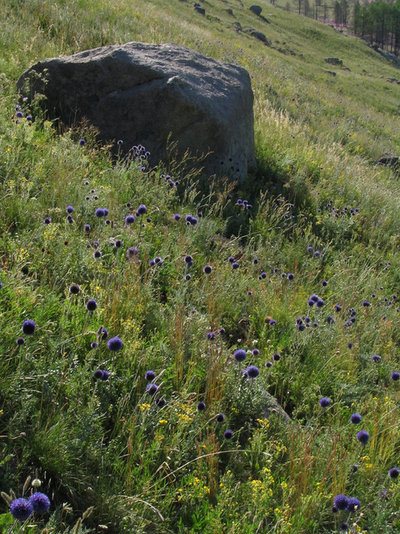
CYAN Horticulture
By studying naturally occurring plant combinations around the globe as well as in the field across the street, we may find the humblest yet most efficient plant combinations.
Here we have a hillside in northern Mongolia covered in a matrix of fine grasses and stunning
globe thistles (
Echinops sp, zones 3 to 9). This simple juxtaposition — airy champagne-colored grasses and bright blue floral balls — is one that can easily be reproduced in garden settings, boulder optional.
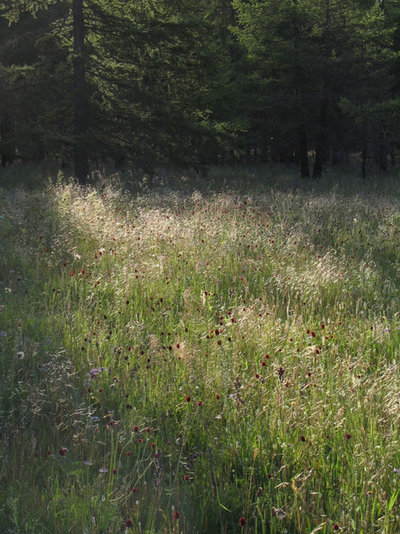
CYAN Horticulture
When we think of grasslands, visions of the rolling vastness of the American Great Plains or the African savannah might come to mind. Yet we do not need endless acreage and a pack of giraffes to establish a hint of a grassland in the yard.
Grasses are found in almost every possible niche, like in this small clearing in a
larch forest close to Siberia. Because of their delicate, often plume-y inflorescences, grasses shine when backlit.
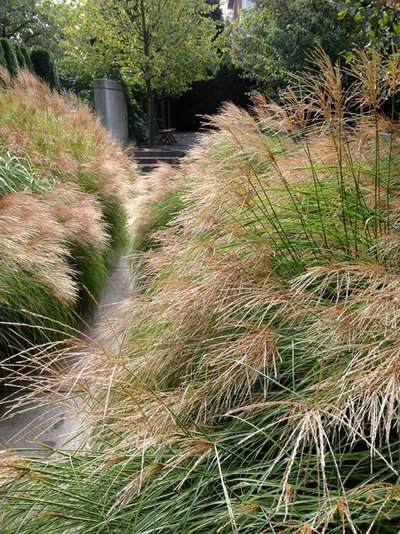
CYAN Horticulture
To re-create some of the magic of grasslands at home, we first need a studied selection of ... grasses. Most retail nurseries maintain an array of ornamental, regionally appropriate and noninvasive selections. Online sources abound as well.
Considering that most true grasses are partial to full sunshine and well-drained soil, we must ensure that our area of design fits this preference — unhappy grasses become drab and floppy. Grouping together several units of the same grass, hence creating dynamic drifts, is both natural and design savvy. In this case masses of tall, easygoing
miscanthus (
Miscanthus sinensis cvs, zones 4 to 9) dress substantial bed areas in this residential Vancouver development.
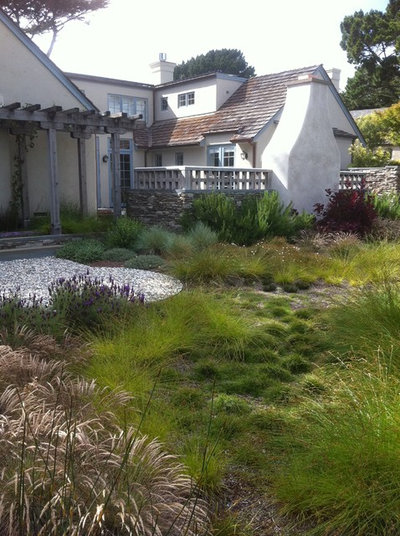
Robert Shuler Design
Several types of grasses make fantastic ground covers, from ankle low (think
fescue and
sesleria) to shoulder high (
switchgrass,
miscanthus). Here we have a smart selection of grasses and a few companion plants that create a tasteful, restful and most likely low-maintenance and drought-tolerant composition.
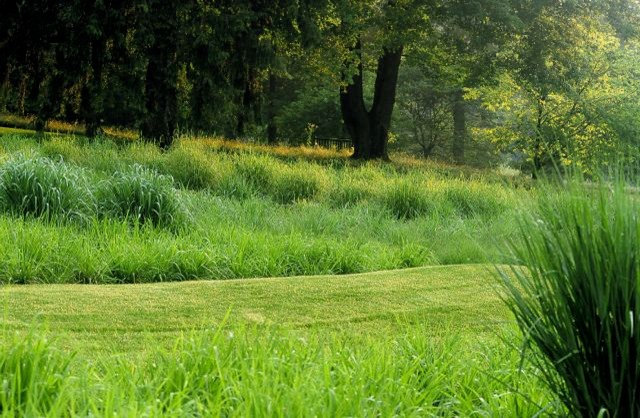
CYAN Horticulture
Restricted to one or multiple types of similar heights, favorite grasses may be evenly applied to any sizable area. It is precisely as a bountiful lawn substitute, or as a tasteful transition between manicured and wild zones, that this design approach shines brightest.
At the Chanticleer garden in Pennsylvania, a large expanse of such grasses is wisely bisected by a neatly mowed lawn path, creating an exemplar minimalist landscape intervention.

AHBL
Later in the season, another example of abundantly massed grasses shows terrific results. In the foreground lie
switchgrass (
Panicum sp) and fountain grass (
Pennisetum sp).
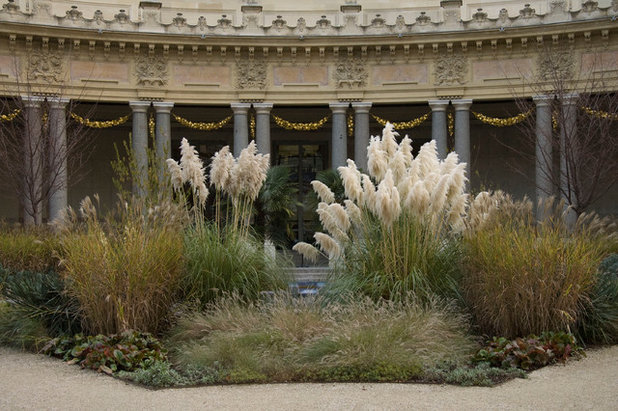
CYAN Horticulture
Associating individual units of different types of grasses may at first sound counterintuitive, if not plain risqué. To reassure ourselves, let’s think of a painter juxtaposing various shades of the same color: The result is all about finesse and subtleties. A marvelous example of this approach can be found in the courtyard of the Petit Palais in Paris, shown here, with
Pampas grasses (Cortaderia sp, zones 6 to 9) dominating this jewel of an all-grass composition.

CYAN Horticulture
A close-up of this exceptional Parisian display reveals the similar colors and textures of these nonetheless different grasses.
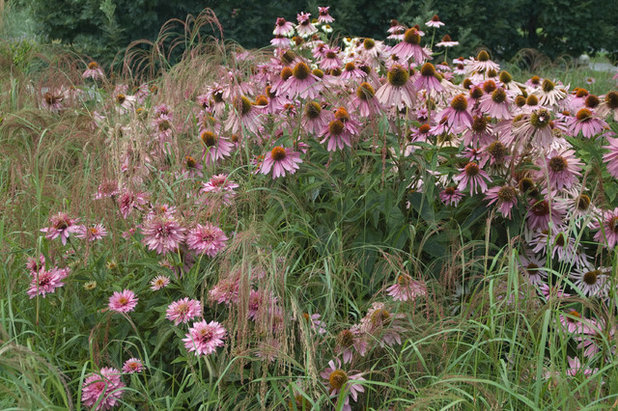
CYAN Horticulture
Numerous flowering perennials make perfect natural companions to grasses. Dotted throughout the composition, they add contrast in foliage and color interest. Asters,
coneflowers (
Echinacea purpurea cvs, zones 3 to 9),
daisies and liatris are some of the best contenders for this job.

CYAN Horticulture
The oh-so-trendy meadow planting style, championed in grand urban schemes like New York's High Line and London’s Olympic Park, is based upon similar naturally occurring plant combinations. Here, the lawn of an abandoned building in Vancouver charmingly flourishes without anybody's consent.
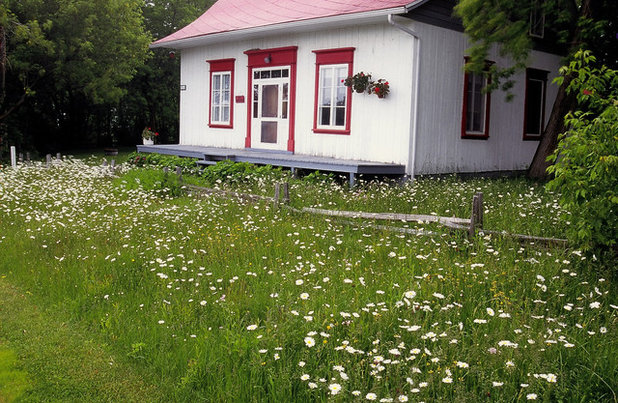
CYAN Horticulture
Simplicity is thus often key. It sometimes takes no more than a broken lawn mower (or prolonged vacations for the gardener) for wild grasses and their flowery companions to reclaim their due. In Lotbinière, Quebec, a summer house goes all natural with a display of
oxeye daisies (
Leucanthemum vulgare, zones 2 to 8) and wild grasses.
More in this series: Shape a Sea-Inspired Garden | Ideas for a Woodland Garden
Devise a Desert Garden | Mighty Mountain Gardens





